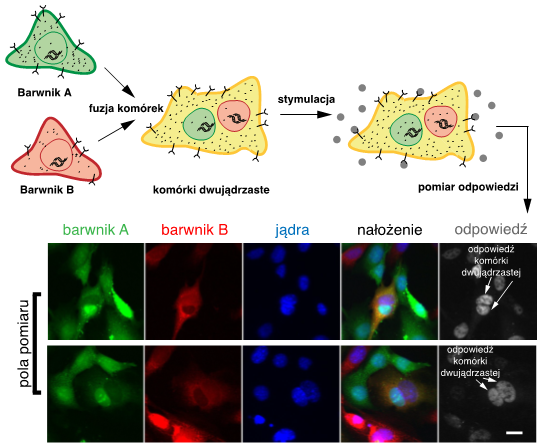Latest research by MSc Piotr Topolewski, and supervised by dr hab. Michał Komorowski, uncovers why the same signaling stimulus can induce variable outcomes among the same cell type in a group of cells or tissue:
“Phenotypic variability, not noise, accounts for most of the cell-to-cell heterogeneity in IFN-γ and oncostatin M signaling responses” (Science Signaling 2022).
In human body trillions of cells, of multiple different cell types communicate with each to coordinate their activities and ensure organism well being. The communication takes place through continuous sending and reading of signals in the form of various biochemical molecules, including cytokines, which regulate inflammatory processes. Biochemical impulses are received through specialized receptors located in the cell membrane. After receiving a message, the receptors trigger a cascade of biochemical reactions inside the cell leading to the generation of an appropriate response to the transmitted signal. Cells that are genetically identical do not respond in the same way to the same signal, and the responses are marker with a considerable cell-to-cell heterogeneity. Scientists assume that the diversity of responses might result from two sources: the different biochemical composition of individual cells and the purely random effects of biochemical reactions inside the cell. In order to discriminate between these two sources of heterogeneity, one would have to examine the responses of cells with the same molecular content, then the diversity of the responses of cells with the same molecular content would be the result of randomness within the cells. If the responses of cells were random, their ability to perceive external stimuli would be limited.
„Conducting a research experiment using cells with identical molecular content and examining whether they respond in the same way to a given stimulus is impossible, because no two biochemically identical cells are present. Living cells change every moment, producing and degrading enzymes or other regulatory proteins. Therefore, we conducted an experiment on binuclear cells and considered one cell with two nuclei as an approximation of two cells with identical molecular composition. Then we stimulated these cells with cytokines, i.e. signaling molecules of the immune system. The responses in both testes turned out to be very similar. Hence our conclusion that the variability observed in nature in responses to the same signal is mainly due to the fact that cells have a different biochemical composition. The molecular content of a cell seems to determine relatively precisely its response to an external stimulus. The perception of the outside world by cells is therefore quite precise, but because each cell is different, it sees this world in a slightly different way” – explains Piotr Topolewski, MSc.

Illulustration: Diagram of the formation and imaging of binuclear cells. The cells were pre-stained in two colors (green or red) so that after fusion, the fused cells contained both dyes (yellow), allowing the fusion to be identified and the cell response measured by microscopic imaging (20 μm scale bar).
„The question to what extent the responses of cells are random, while inspired by curiosity, has a practical aspect. A better understanding of cell signaling could contribute to more effective design of therapeutic strategies. Aberrations in signal transduction occur in many diseases, including cancer and chronic inflammatory diseases, and these processes constitute a target of many drugs. When constructing these drugs, it was initially assumed that activation of a specific receptor or a specific signaling pathway leads to a specific cell response and therefore pharmacological inhibition or activation by these drugs should induce a specific change in cell behavior. In practice, however, drugs designed according to this concept turned out to be much less effective than expected” – says Prof. Michał Komorowski.
Both scientists are conducting research at the Department of Biosystems and Soft Matter of the Institute of Industrial Sciences of the Polish Academy of Sciences. Prof. Michał Komorowski is a mathematician and a very experienced specialist in the field of cell signaling and information theory. MSc. Piotr Topolewski is a biotechnologist and is preparing to defend his doctoral dissertation. Currently, they are leading research works under two IPPT PAN projects:
- „Decoding biochemical signaling to design more effective therapeutic strategies”, FNP, POIR, head: Michał Komorowski.
- „Explaining the sources of intercellular variability of interferon gamma responsem”, NCN, PRELUDIUM, principal investigator: Piotr Topolewski.
The research team led by prof. Michał Komorowski is looking for a postdoc interested in working on these issues. More information: sysbiosig.org















